power steering fluid FORD FIESTA 2007 Workshop Manual
[x] Cancel search | Manufacturer: FORD, Model Year: 2007, Model line: FIESTA, Model: FORD FIESTA 2007Pages: 1226, PDF Size: 61.26 MB
Page 29 of 1226
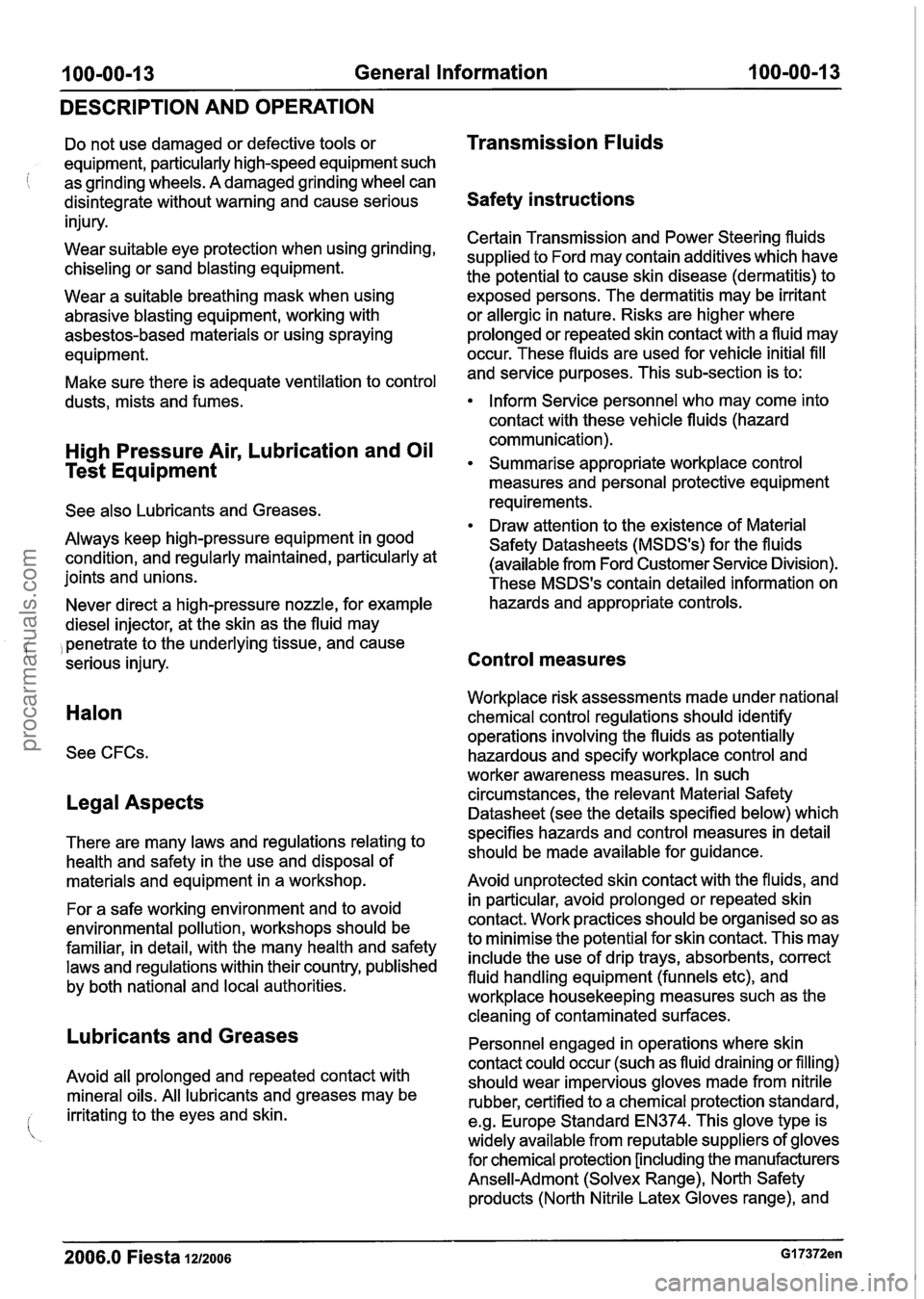
100-00-1 3 General Information 100-00-1 3
DESCRIPTION AND OPERATION
Do not use damaged or defective tools or
equipment, particularly high-speed equipment such
i as grinding wheels. A damaged grinding wheel can
disintegrate without warning and cause serious
injury.
Wear suitable eye protection when using grinding,
chiseling or sand blasting equipment.
Wear a suitable breathing mask when using
abrasive blasting equipment, working with
asbestos-based materials or using spraying
equipment.
Make sure there is adequate ventilation to control
dusts, mists and fumes.
High Pressure Air, Lubrication and Oil
Test Equipment
See also Lubricants and Greases.
Always keep high-pressure equipment in good
condition, and regularly maintained, particularly at
joints and unions.
Never direct a high-pressure nozzle, for example
diesel injector, at the skin as the fluid may
, penetrate to the underlying tissue, and cause
serious injury.
Halon
See CFCs.
Legal Aspects
There are many laws and regulations relating to
health and safety in the use and disposal of
materials and equipment in a workshop.
For a safe working environment and to avoid
environmental pollution, workshops should be
familiar, in detail, with the many health and safety
laws and regulations within their country, published
by both national and local authorities.
Lubricants and Greases
Avoid all prolonged and repeated contact with
mineral oils. All lubricants and greases may be
irritating to the eyes and skin.
'
Transmission Fluids
Safety instructions
Certain Transmission and Power Steering fluids
supplied to Ford may contain additives which have
the potential to cause skin disease (dermatitis) to
exposed persons. The dermatitis may be irritant
or allergic in nature. Risks are higher where
prolonged or repeated skin contact with a fluid may
occur. These fluids are used for vehicle initial
fill
and service purposes. This sub-section is to:
Inform Service personnel who may come into
contact with these vehicle fluids (hazard
communication).
Summarise appropriate workplace control
measures and personal protective equipment
requirements.
Draw attention to the existence of Material
Safety Datasheets (MSDS's) for the fluids
(available from Ford Customer Service Division).
These MSDS's contain detailed information on
hazards and appropriate controls.
Control measures
Workplace risk assessments made under national
chemical control regulations should identify
operations involving the fluids as potentially
hazardous and specify workplace control and
worker awareness measures. In such
circumstances, the relevant Material Safety
Datasheet (see the details specified below) which
specifies hazards and control measures in detail
should be made available for guidance.
Avoid unprotected skin contact with the fluids, and
in particular, avoid prolonged or repeated skin
contact. Work practices should be organised so as
to minimise the potential for skin contact. This may
include the use of drip trays, absorbents, correct
fluid handling equipment (funnels etc), and
workplace housekeeping measures such as the
cleaning of contaminated surfaces.
Personnel engaged in operations where skin
contact could occur (such as fluid draining or filling)
should wear impervious gloves made from
nitrile
rubber, certified to a chemical protection standard,
e.g. Europe Standard EN374. This glove type is
widely available from reputable suppliers of gloves
for chemical protection [including the manufacturers
Ansell-Admont
(Solvex Range), North Safety
products (North
Nitrile Latex Gloves range), and
2006.0 Fiesta 1212006 GI 7372en
procarmanuals.com
Page 39 of 1226
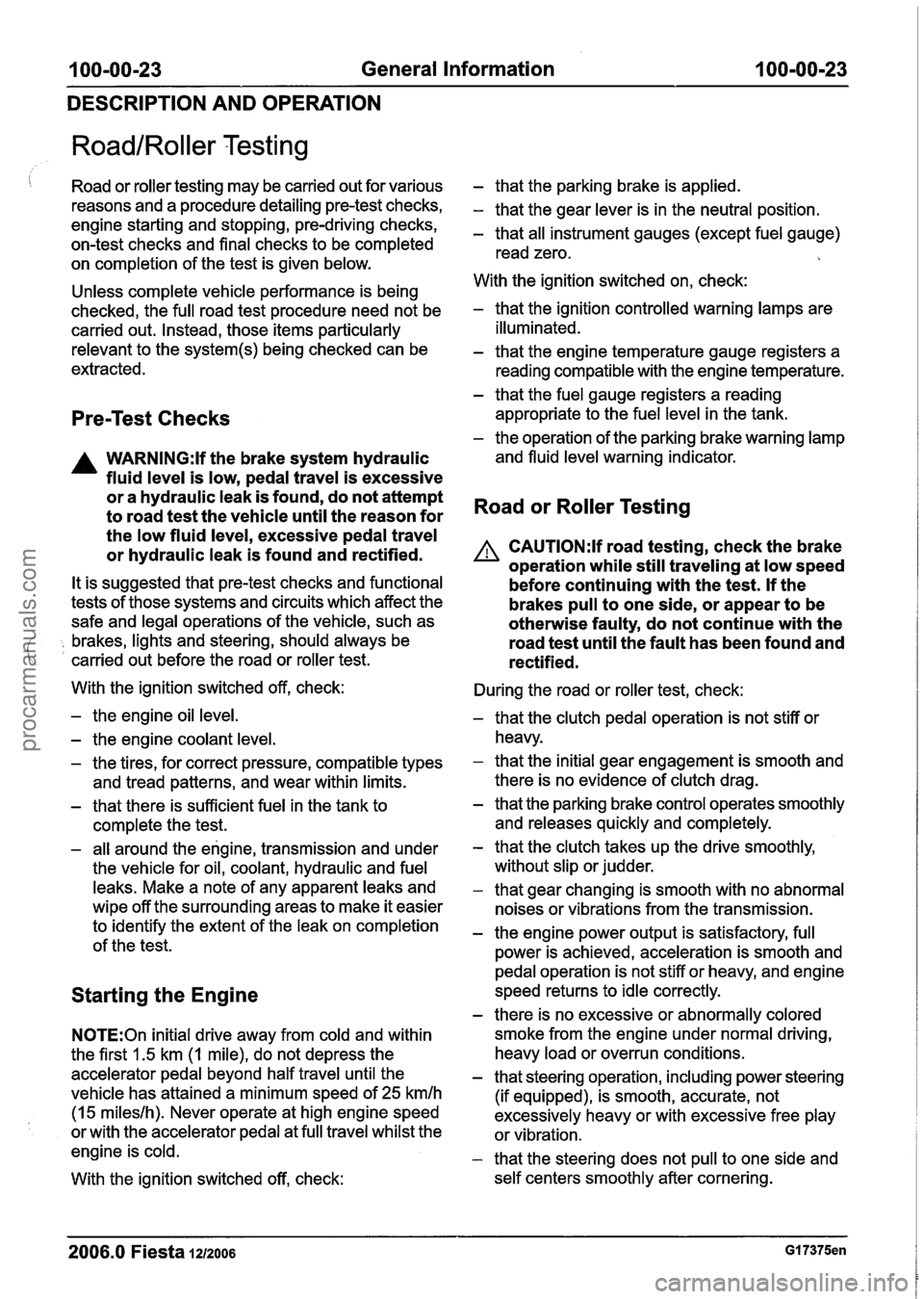
100-00-23 General Information 100-00-23
DESCRIPTION AND OPERATION
RoadIRoller Testing
I Road or roller testing may be carried out for various
reasons and a procedure detailing pre-test checks,
engine starting and stopping, pre-driving checks,
on-test checks and final checks to be completed
on completion of the test is given below.
Unless complete vehicle performance is being
checked, the full road test procedure need not be
carried out. Instead, those items particularly
relevant to the
system(s) being checked can be
extracted.
Pre-Test Checks
A WARNING:lf the brake system hydraulic
fluid level is low, pedal travel is excessive
or a hydraulic leak is found, do not attempt
to road test the vehicle until the reason for
the low fluid level, excessive pedal travel
or hydraulic leak is found and rectified.
It is suggested that pre-test checks and functional
tests of those systems and circuits which affect the
safe and legal operations of the vehicle, such as
( , brakes, lights and steering, should always be
carried out before the road or roller test.
With the ignition switched off, check:
- the engine oil level.
- the engine coolant level.
- the tires, for correct pressure, compatible types
and tread patterns, and wear within limits.
- that there is sufficient fuel in the tank to
complete the test.
- all around the engine, transmission and under
the vehicle for oil, coolant, hydraulic and fuel
leaks. Make a note of any apparent leaks and
wipe off the surrounding areas to make it easier
to identify the extent of the leak on completion
of the test.
Starting the Engine
N0TE:On initial drive away from cold and within
the first 1.5 km (1 mile), do not depress the
accelerator pedal beyond half travel until the
vehicle has attained a minimum speed of
25 kmlh
(15 mileslh). Never operate at high engine speed
or with the accelerator pedal at full travel whilst the
engine is cold.
With the ignition switched off, check:
- that the parking brake is applied.
- that the gear lever is in the neutral position.
- that all instrument gauges (except fuel gauge)
read zero.
With the ignition switched on, check:
- that the ignition controlled warning lamps are
illuminated.
- that the engine temperature gauge registers a reading compatible with the engine temperature.
- that the fuel gauge registers a reading
appropriate to the fuel level in the tank.
- the operation of the parking brake warning lamp
and fluid level warning indicator.
Road or Roller Testing
A CAUTI0N:lf road testing, check the brake
operation while still traveling at low speed
before continuing with the test. If the
brakes pull to one side, or appear to be
otherwise faulty, do not continue with the
road test until the fault has been found and
rectified.
During the road or roller test, check:
- that the clutch pedal operation is not stiff or
heavy.
- that the initial gear engagement is smooth and
there is no evidence of clutch drag.
- that the parking brake control operates smoothly
and releases quickly and completely.
- that the clutch takes up the drive smoothly,
without slip or judder.
- that gear changing is smooth with no abnormal
noises or vibrations from the transmission.
- the engine power output is satisfactory, full
power is achieved, acceleration is smooth and
pedal operation is not stiff or heavy, and engine
speed returns to idle correctly.
- there is no excessive or abnormally colored
smoke from the engine under normal driving,
heavy load or overrun conditions.
- that steering operation, including power steering
(if equipped), is smooth, accurate, not
excessively heavy or with excessive free play
or vibration.
- that the steering does not pull to one side and
self centers smoothly after cornering.
2006.0 Fiesta 1212006 GI 7375en
procarmanuals.com
Page 65 of 1226
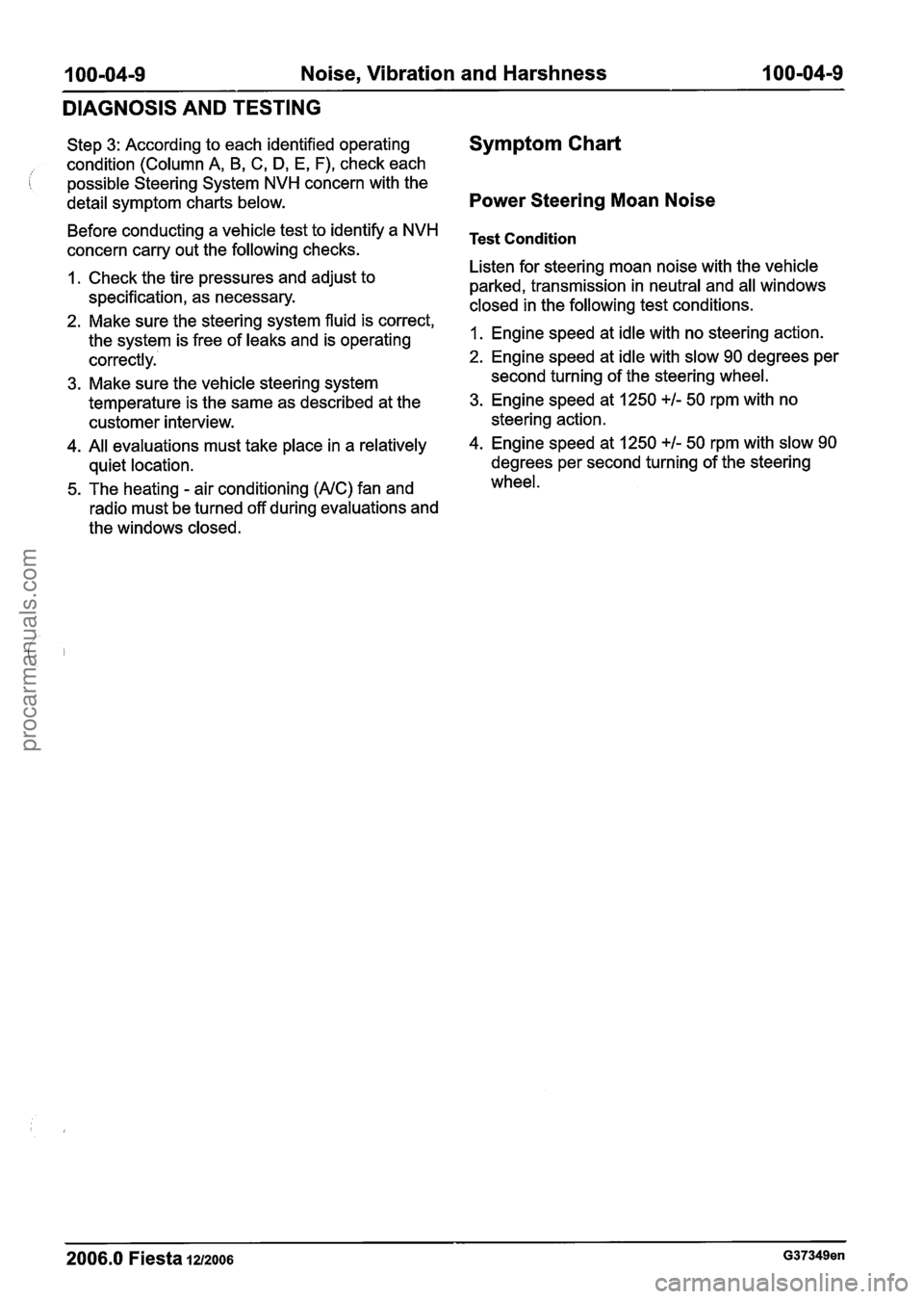
100-04-9 Noise, Vibration and Harshness 1 00-04-9
DIAGNOSIS AND TESTING
Step 3: According to each identified operating
condition (Column A, B,
C, D, E, F), check each
possible Steering System
NVH concern with the
detail symptom charts below.
Before conducting a vehicle test to identify a
NVH
concern carry out the following checks.
1. Check the tire pressures and adjust to
specification, as necessary.
2. Make sure the steering system fluid is correct,
the system is free of leaks and is operating
correctly.
3. Make sure the vehicle steering system
temperature is the same as described at the
customer interview.
4. All evaluations must take place in a relatively
quiet location.
5. The heating
- air conditioning (AIC) fan and
radio must be turned off during evaluations and
the windows closed.
Symptom Chart
Power Steering Moan Noise
Test Condition
Listen for steering moan noise with the vehicle
parked, transmission in neutral and all windows
closed in the following test conditions.
1. Engine speed at idle with no steering action.
2. Engine speed at idle with slow 90 degrees per
second turning of the steering wheel.
3. Engine speed at 1250 +I- 50 rpm with no
steering action.
4. Engine speed at 1250 +I- 50 rpm with slow 90
degrees per second turning of the steering
wheel.
2006.0 Fiesta 12/2006 G37349en
procarmanuals.com
Page 66 of 1226
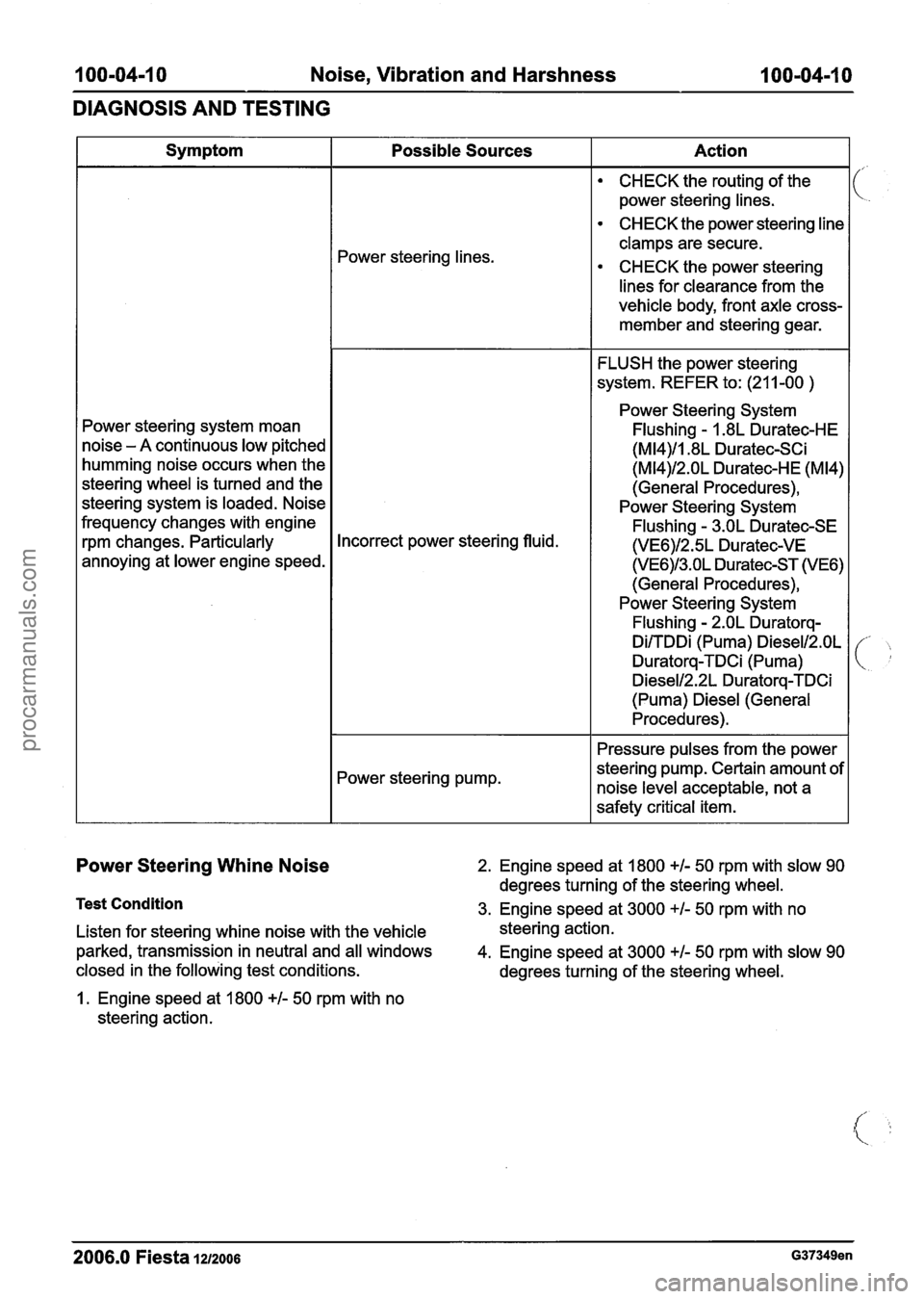
100-04-1 0 Noise, Vibration and Harshness 100-04-10
DIAGNOSIS AND TESTING
Power Steering Whine Noise 2. Engine speed at 1800 +/- 50 rpm with slow 90
degrees turning of the steering wheel.
Test Condition 3. Engine speed at 3000 +I- 50 rpm with no
Listen for steering whine noise with the vehicle steering action.
parked, transmission in neutral and all windows
4. Engine speed at 3000
+I- 50 rpm with slow 90
closed in the following test conditions. degrees turning of the steering wheel.
1. Engine speed at 1800
+I- 50 rpm with no
steering action. Symptom
Power steering system moan
noise
- A continuous low pitched
humming noise occurs when the
steering wheel is turned and the
steering system is loaded. Noise
frequency changes with engine
rpm changes. Particularly
annoying at lower engine speed.
2006.0 Fiesta 1212006 G37349en
Possible Sources
Power steering lines.
Incorrect power steering fluid.
Power steering pump. Action
CHECK
the routing of the
power steering lines.
CHECK the power steering line
clamps are secure.
CHECK the power steering
lines for clearance from the
vehicle body, front axle cross-
member and steering gear.
FLUSH the power steering
system. REFER to: (21 1-00
)
Power Steering System
Flushing
- I .8L Duratec-HE
(M14)/1.8L Duratec-SCi
(M14)/2.OL Duratec-HE (M14)
(General Procedures),
Power Steering System
Flushing
- 3.OL Duratec-SE
(VE6)/2.5L Duratec-VE
(VE6)/3.OL Duratec-ST (VE6)
(General Procedures),
Power Steering System
Flushing
- 2.OL Duratorq-
DirrDDi (Puma) Diesel12.0L
Duratorq-TDCi (Puma)
Diesell2.2L Duratorq-TDCi
(Puma) Diesel (General
Procedures).
Pressure pulses from the power
steering pump. Certain amount of
noise level acceptable, not a
safety critical item.
procarmanuals.com
Page 67 of 1226
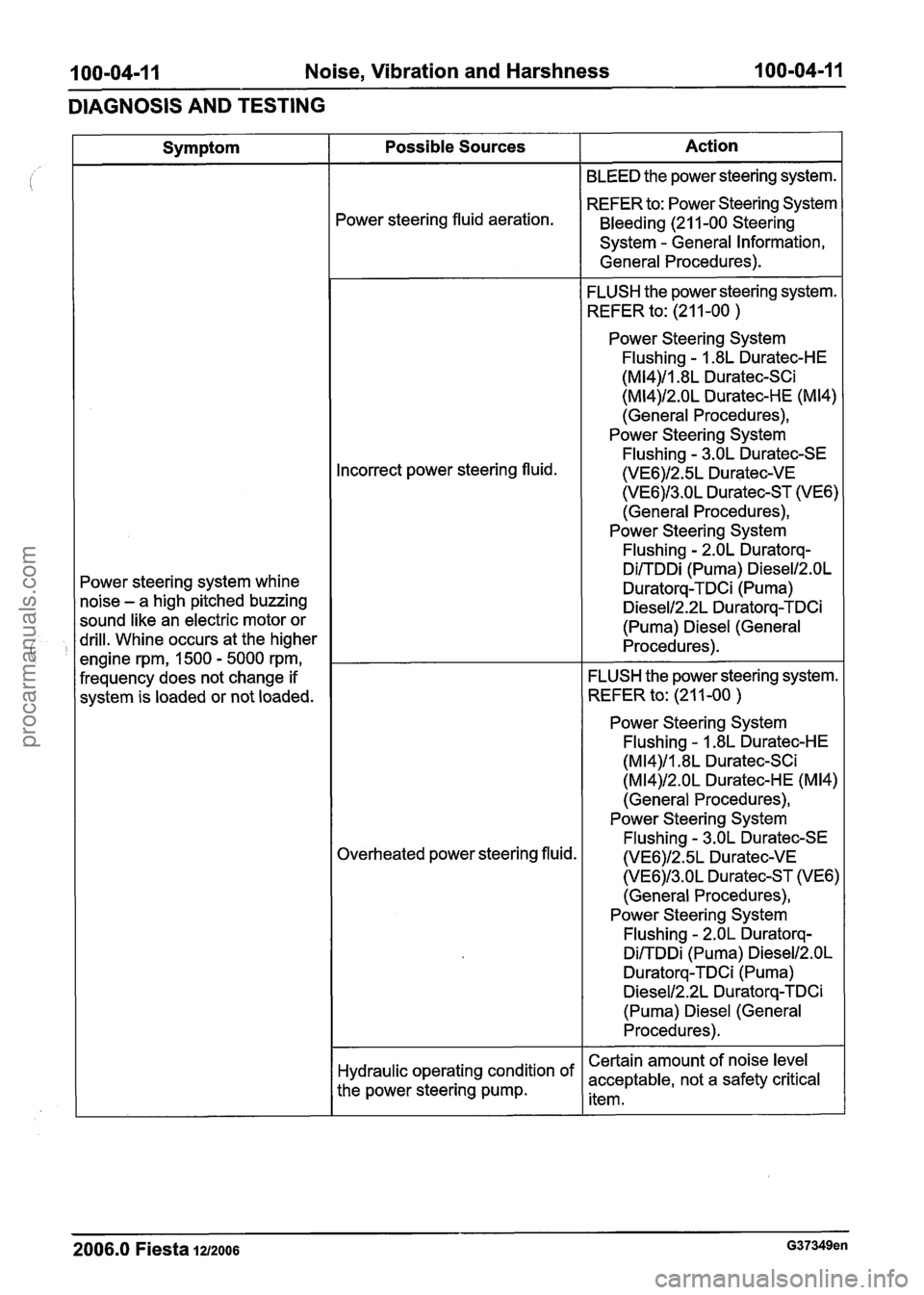
100-04-1 1 Noise, Vibration and Harshness 100=04=1 I
DIAGNOSIS AND TESTING
2006.0 Fiesta 1212006 G37349en
Symptom
Power steering system whine
noise
- a high pitched buzzing
sound like an electric motor or
drill. Whine occurs at the higher
engine rpm, 1500
- 5000 rpm,
frequency does not change if
system is loaded or not loaded.
Possible Sources
Power steering fluid aeration.
l ncorrect power steering fluid.
Overheated power steering fluid.
'perating condition of
the power steering pump.
Action
BLEED the power steering system.
REFER to: Power Steering System
Bleeding (21 1-00 Steering
System
- General Information,
General Procedures).
FLUSH the power steering system.
REFER
to: (21 1-00 )
Power Steering System
Flushing
- 1.8L Duratec-HE
(M14)/1.8L Duratec-SCi
(M14)/2.OL Duratec-HE (M14)
(General Procedures),
Power Steering System Flushing
- 3.OL Duratec-SE
(VE6)/2.5L Duratec-VE
(VE6)/3.OL Duratec-ST (VE6)
(General Procedures),
Power Steering System Flushing
- 2.OL Duratorq-
DilTDDi (Puma) Diesel12.0L
Duratorq-TDCi (Puma)
DieselI2.2L Duratorq-TDCi
(Puma) Diesel (General Procedures).
FLUSH the power steering system.
REFER to: (21 1-00
)
Power Steering System
Flushing
- 1.8L Duratec-HE
(M14)/1.8L Duratec-SCi
(M14)/2.OL Duratec-HE (M14)
(General Procedures),
Power Steering System Flushing
- 3.OL Duratec-SE
(VE6)/2.5L Duratec-VE
(VE6)/3.OL Duratec-ST (VE6)
(General Procedures),
Power Steering System Flushing
- 2.OL Duratorq-
DilTDDi (Puma) Diesel12.0L
Duratorq-TDCi (Puma)
Diesel12.2L Du ratorq-TDCi
(Puma) Diesel (General
Procedures).
Certain amount of noise level
acceptable, not a safety critical
item.
procarmanuals.com
Page 71 of 1226
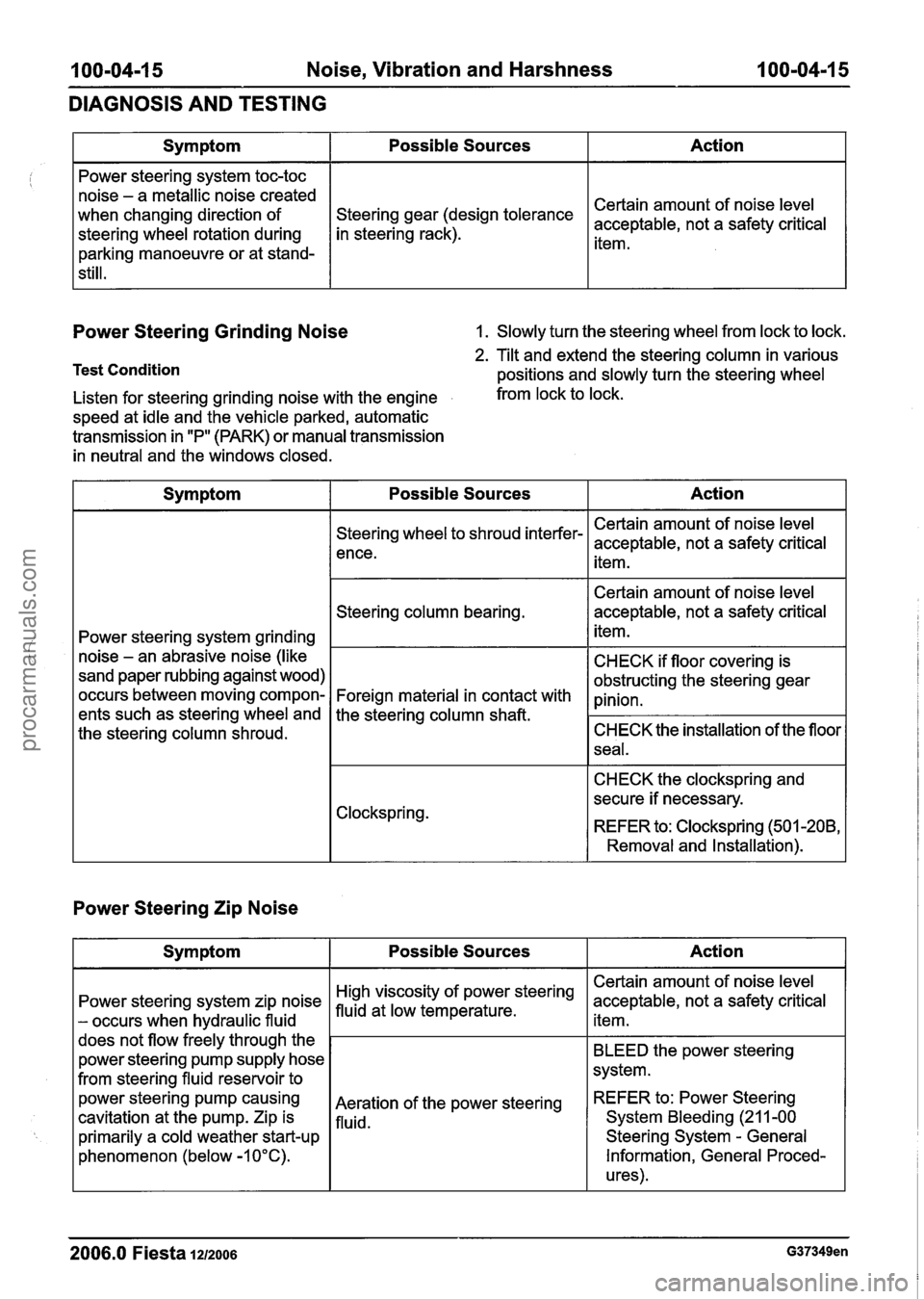
100-04-15 Noise, Vibration and Harshness 100-04-15
DIAGNOSIS AND TESTING
Power Steering Grinding Noise 1. Slowly turn the steering wheel from lock to lock.
Test Condition
Action
Certain amount of noise level
acceptable, not a safety critical
item.
Symptom
Power steering system toc-toc
noise - a metallic noise created
when changing direction of
steering wheel rotation during
parking manoeuvre or at stand-
still.
2. Tilt and extend the steering column in various
positions and slowly turn the steering wheel
Possible Sources
gear (design tolerance
in steering rack).
Listen for steering grinding noise with the engine from lock to lock.
speed at idle and the vehicle parked, automatic
transmission in "P" (PARK) or manual transmission
in neutral and the windows closed.
Power Steering Zip Noise
Symptom Possible Sources Action
Power steering system grinding
noise
- an abrasive noise (like
sand paper rubbing against wood)
occurs between moving compon-
ents such as steering wheel and
the steering column shroud.
2006.0 Fiesta 1212006 G37349en
Steering wheel to shroud interfer-
ence.
Steering column bearing.
Foreign material in contact with
the steering column
shaft.
Clockspring.
Action
Certain amount of noise level
acceptable, not a safety critical item.
BLEED the power steering
system.
REFER
to: Power Steering
System Bleeding
(21 1-00
Steering System
- General
Information, General Proced-
ures).
Symptom
Power steering system zip noise
- occurs when hydraulic fluid
does not flow freely through the
power steering pump supply hose
from steering fluid reservoir to
power steering
pump causing
cavitation
at the pump. Zip is
primarily a cold weather start-up
phenomenon (below -1 0°C). Certain amount
of noise level
acceptable, not a safety critical
item.
Certain amount of noise level
acceptable, not a safety critical
item.
CHECK if floor covering is
obstructing the steering gear
pinion.
CHECK the installation of the floor
seal.
CHECK the clockspring and
secure if necessary.
REFER to: Clockspring (501
-208,
Removal and Installation).
Possible Sources
steering
Aeration of the power steering
fluid.
procarmanuals.com
Page 158 of 1226
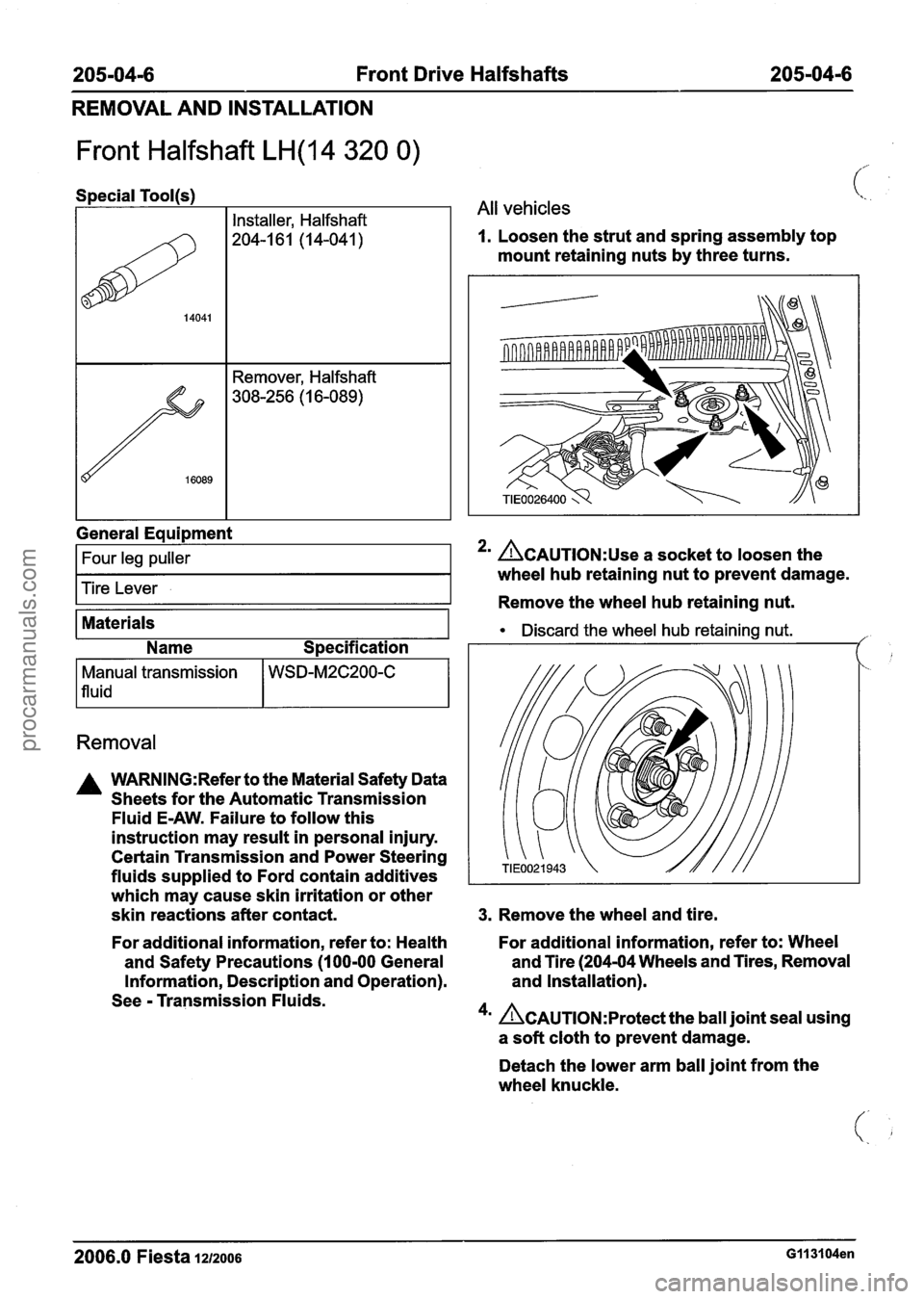
205-04-6 Front Drive Halfshafts 205-04-6
REMOVAL AND INSTALLATION
Front Halfshaft LH(14 320 0)
I I Installer, Halfshaft
(%. .
1 All vehicles
1. Loosen the strut and spring assembly top
mount retaining nuts by three turns.
General
Eaui~ment
I Four leg puller I
Tire Lever
Materials
Name Specification
Removal
Manual transmission
1 fluid
A WARNING:Refer to the Material Safety Data
Sheets for the Automatic Transmission
Fluid
E-AW. Failure to follow this
instruction may result in personal injury.
Certain Transmission and Power Steering
fluids supplied to Ford contain additives
which may cause skin irritation or other
skin reactions after contact.
WSD-M2C200-C
2' ACAUTION:~~~ a socket to loosen the
wheel hub retaining nut to prevent damage.
Remove the wheel hub retaining nut.
Discard the wheel hub retaining nut. ,'
3. Remove the wheel and tire.
For additional information, refer to: Health For
additional information, refer to: Wheel
and Safety Precautions
(1 00-00 General and
Tire (204-04 Wheels and Tires, Removal
Information, Description and Operation). and
Installation).
See
- Transmission Fluids.
4m Ac~u~10~:~rotect the ball joint seal using
a soft cloth to prevent damage.
Detach the lower arm ball joint from the
wheel knuckle.
2006.0 Fiesta IZIZOO~ G113104en
procarmanuals.com
Page 165 of 1226
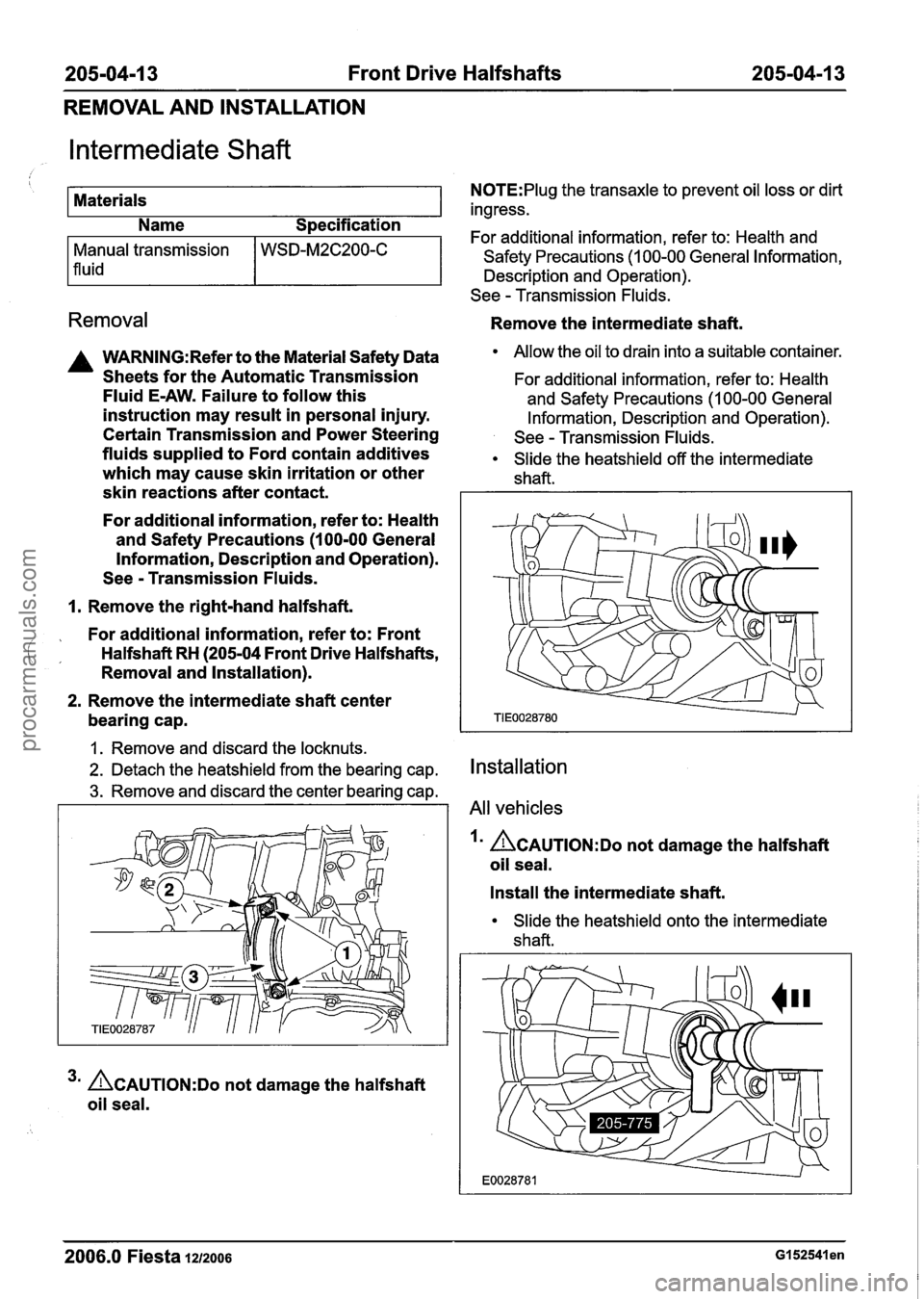
205-04-1 3 Front Drive Halfshafts 205-04-1 3
REMOVAL AND INSTALLATION
Intermediate Shaft
I
Materials
Name Specification
Removal
Manual transmission
1 fluid
A WARN1NG:Refer to the Material Safety Data
Sheets for the Automatic Transmission
Fluid E-AW. Failure to follow this
instruction may result in personal injury.
Certain Transmission and Power Steering
fluids supplied to Ford contain additives
which may cause skin irritation or other
skin reactions after contact.
WSD-M2C200-C
For additional information, refer to: Health
and Safety Precautions
(1 00-00 General
Information, Description and Operation).
See
- Transmission Fluids.
I. Remove the right-hand halfshaft.
, For additional information, refer to: Front
i, Halfshaft RH (205-04 Front Drive Halfshafts,
Removal and Installation).
2. Remove the intermediate shaft center
bearing cap.
1. Remove and discard the locknuts.
2. Detach the heatshield from the bearing cap.
3. Remove and discard the center bearing cap.
3m ACAUTION:D~ not damage the halfshaft
oil seal.
N0TE:Plug the transaxle to prevent oil loss or dirt
ingress.
For additional information, refer to: Health and
Safety Precautions
(1 00-00 General Information,
Description and Operation).
See
- Transmission Fluids.
Remove the intermediate shaft.
Allow the oil to drain into a suitable container.
For additional information, refer to: Health
and Safety Precautions
(I 00-00 General
Information, Description and Operation).
See
- Transmission Fluids.
Slide the heatshield off the intermediate
shaft.
Installation
All vehicles
I' ACAUTION:D~ not damage the halfshaft
oil seal.
Install the intermediate shaft.
Slide the heatshield onto the intermediate
shaft.
2006.0 Fiesta 1212006 GI 52541 en
procarmanuals.com
Page 322 of 1226
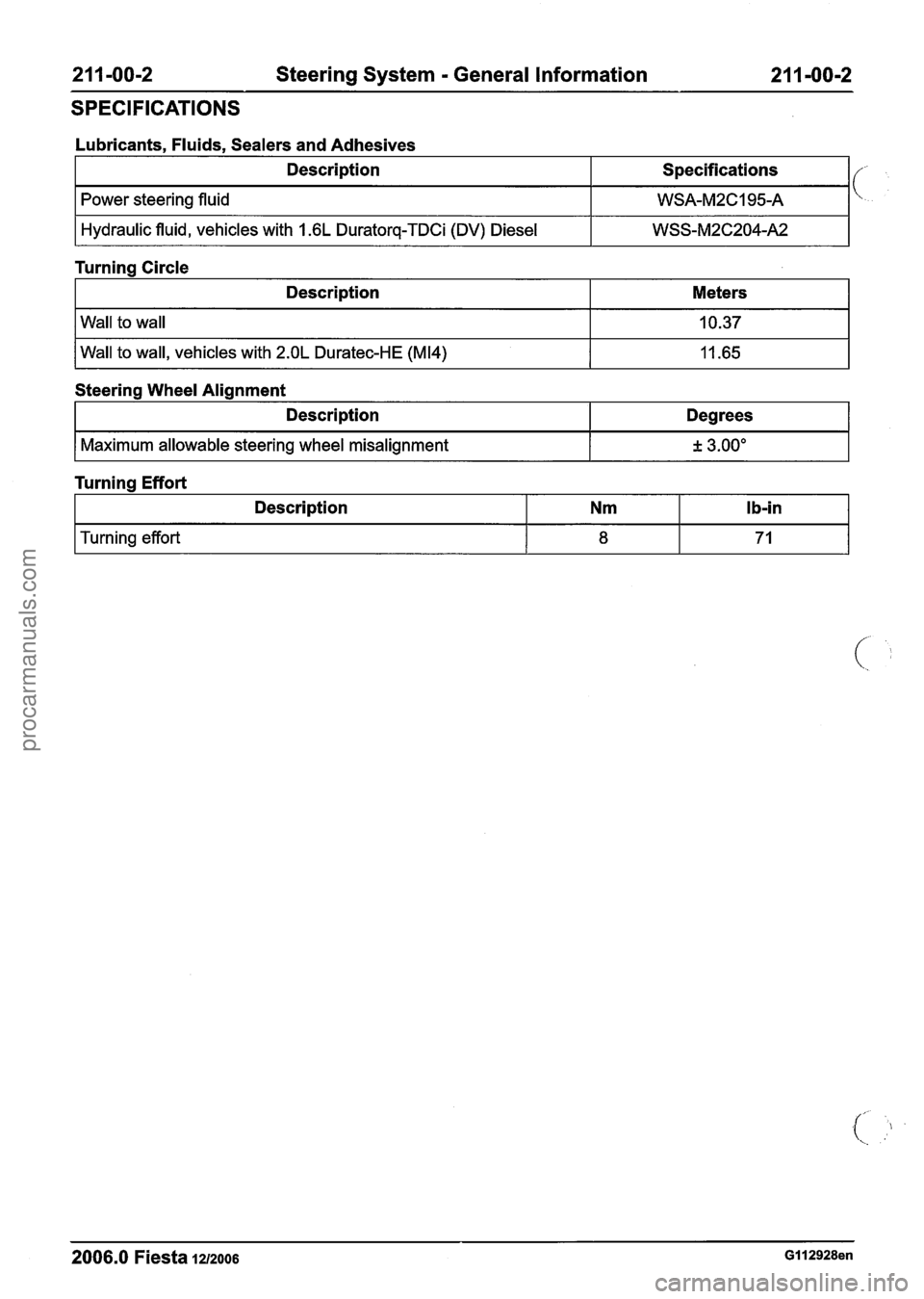
21 1-00-2 Steering System - General Information 21 1-00-2
SPECIFICATIONS
Lubricants, Fluids, Sealers and Adhesives
Turning Circle Description
Power
steering fluid
Hydraulic fluid, vehicles with
1.6L Duratorq-TDCi (DV) Diesel
I Description I Meters I
Specifications
WSA-M2C195-A
WSS-M2C204-A2
I Wall to wall, vehicles with 2.OL Duratec-HE (M14) I 11.65 I
I Maximum allowable steering wheel misalignment I k 3.00" I
Steering Wheel Alignment
Turning Effort Description
Description
Nm Ib-in
Turning effort
Degrees
2006.0 Fiesta 1212006 GI I 2928en
procarmanuals.com
Page 324 of 1226
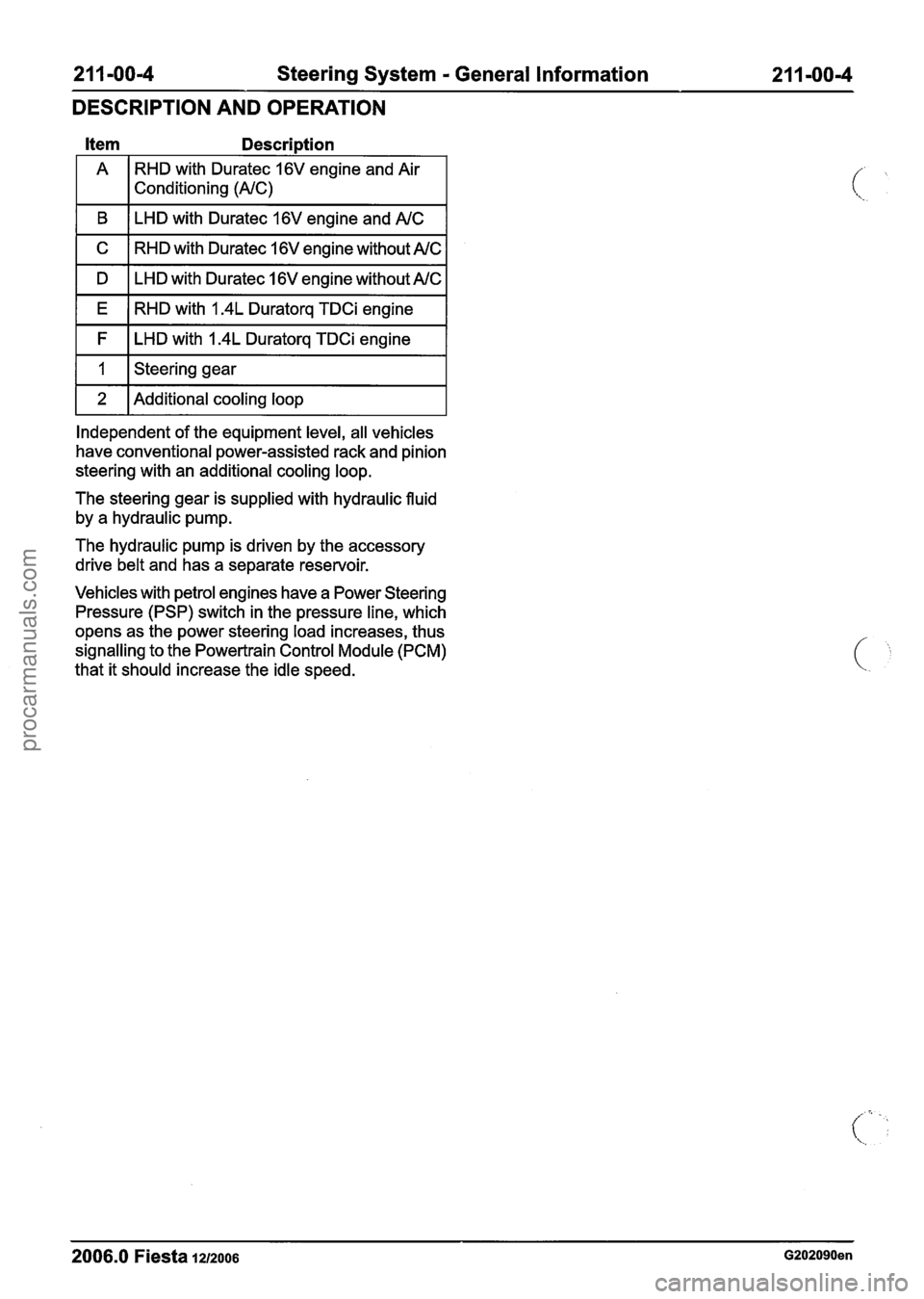
21 1-00-4 Steering System - General Information 21 1-00-4
DESCRIPTION AND OPERATION
Item Descri~tion
A
RHD with Duratec 16V engine and Air
1 I Conditioning (NC)
I B I LHD with Duratec 16V engine and NC I
I C I RHD with Duratec 16V engine without AM: I
I D I LHD with Duratec 16V engine without NC I
I E ( RHD with 1.4L Duratorq TDCi engine I
I F I LHD with 1.4L Duratorq TDCi engine I
I I I Steering gear I
1 2 1 Additional cooling loop I
Independent of the equipment level, all vehicles
have conventional power-assisted rack and pinion
steering with an additional cooling loop.
The steering gear is supplied with hydraulic fluid
by a hydraulic pump.
The hydraulic pump is driven by the accessory
drive belt and has a separate reservoir.
Vehicles with petrol engines have a Power Steering
Pressure (PSP) switch in the pressure line, which
opens as the power steering load increases, thus
signalling to the Powertrain Control Module (PCM)
that it should increase the idle speed.
- - -- - -
2006.0 Fiesta 1212006 G202090en
procarmanuals.com